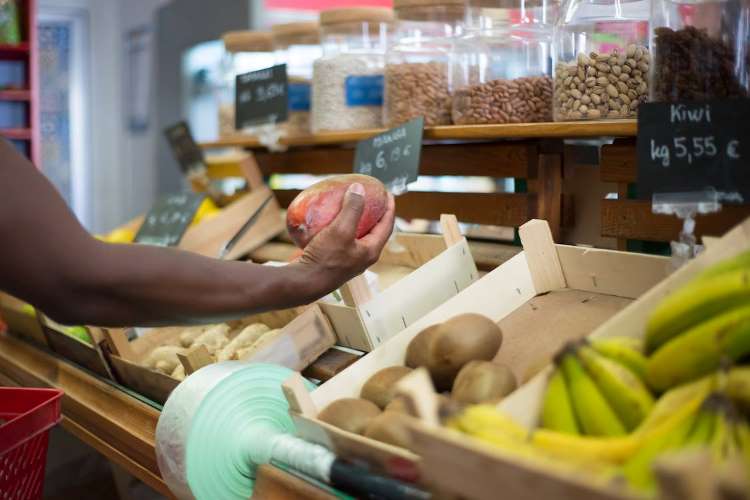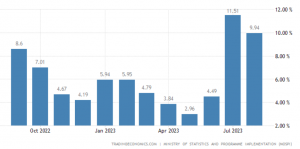
Rising food inflation in India: An unrelenting rise of food prices is causing unease across India’s vibrant urban areas and sleepy villages alike. As households struggle to make both ends meet, policymakers are confronted with the question of how to tame the galloping food prices that threaten both economic stability and everyday life. The retail inflation in pulses, cereals, and spices stayed in double digits in August, despite a slight moderation. While the Consumer Price Index (CPI) recorded food inflation at 9.2% in August 2023, cereal inflation was reported at 11.8%.
Although vegetable prices moderated, the high prices of non-perishable food items, compounded by surging onion rates, have kept concerns about price pressures alive. Retail inflation for onions reached a staggering 23.18% in August, a significant jump from 11.78% in July. Onion prices maintained their upward trend in September.
READ | Common Services Centres: Bridging digital divide for rural women
In the most recent Monetary Policy Committee meeting, threats to food prices, such as the volatile state of El Nino, fluctuating global food prices, and irregular monsoon patterns were discussed. The MPC recognised the pressing need for continuous monitoring due to potential severe impacts on food prices.
Anticipating further food price shocks, the Reserve Bank of India’s monetary policy committee adopted a cautious stance in their August review, leaving the policy repo rate unchanged at 6.5% for the third consecutive time.
What causes high food inflation
Global challenges, including supply pressures due to the Russia-Ukraine war, compounded by India’s suboptimal monsoon this year affecting crop yields, have contributed to the surge. Quanteco Research highlighted potential price pressures from expected shortfalls in Kharif paddy yields and the yearly decline in the area sown under Kharif pulses. The limited wheat stock with the Food Corporation of India further complicates the issue.
Persistent food inflation in India

India’s attempts to regulate inflation led to export bans on wheat and rice in May and September 2022. However, a study by the Indian Council of Applied Economic Research critiqued these as reactive measures. The bans not only failed to control inflation but also resulted in a loss of over Rs 40,000 crore for farmers, causing heightened concern among India’s trade partners. Previous wheat export bans contributed to market instability rather than alleviating inflation.
The government also set stocking limits for wheat traders and millers in June 2023. Subsequent months saw additional measures, including an export ban on non-basmati white rice and increased export duties on rice and onions. Ironically, these bans were imposed while food security was a priority at the G20.
Earlier this year, surging tomato prices disrupted household budgets. Emkay Global Financial Services noted that while tomato prices have stabilised, consistent inflation for non-perishables has kept overall inflation high. Addressing this requires the prompt development of supply-side policies.
Several experts have proposed strategies for effectively managing food inflation. Recommendations include adjusting trade policies to prevent sales below the minimum support price (MSP) and ensuring transparency. Previous government efforts, such as those with edible oils in 2021-22, offer valuable lessons. Further suggestions include reducing wheat import duties and establishing buffer stocks for volatile vegetables, benefiting both farmers and consumers.
The government needs to strike a balance between farmer and consumer needs. Current policies seem skewed towards urban consumers, indirectly transferring resources from farmers to consumers.
Inflation for wheat eased to 9.33% in August from 11.94% in July 2023. But this trend might not continue due to the government’s lower wheat procurement this season. Some respite may come from government actions like the Rs 200 reduction in LPG cylinder retail prices and decreasing tomato rates. Nonetheless, the average Q2 FY24 CPI inflation is projected to exceed the RBI’s 6.2% estimate by 40-50 basis points.
Navigating the food inflation crisis is no easy feat; it is a nuanced challenge that intersects global geopolitics, unpredictable weather patterns, and intricate economic policies. As India charts its course through this crisis, the delicate balance between ensuring farmer welfare and consumer affordability emerges as a paramount concern. The road ahead may be uncertain, but with informed policies, vigilant monitoring, and a commitment to both producers and consumers, India stands poised to confront this economic challenge.
